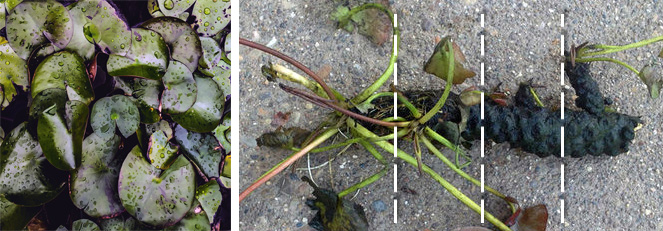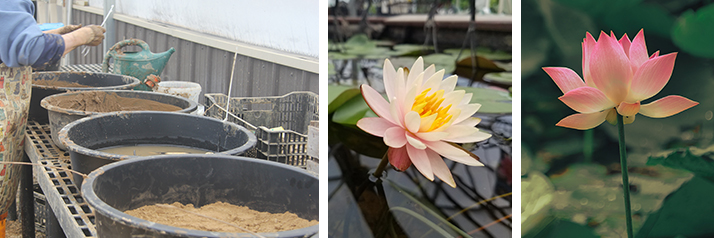Learn How to Divide Water Lilies and Lotus
Did you know that dividing your water lilies and lotus is a good way to add protection for your pond fish with what you already have?

Pond plants, particularly water lilies and lotus, covering the pond’s surface has an optimal range in being beneficial. Too little coverage and the water gets super-heated from UV rays of the sun, algae blooms happen more frequently and fish feel over-exposed to predatory birds. Too much coverage (75% or more) and the plants start creating a “greenhouse” effect. Water starts holding heat, toxic gases do not exchange as easily with life-giving oxygen at the surface and damaging insects can transfer freely from one plant to the next with no worry of being eaten by fish.
Your pond’s water surface should ideally have 40-60% coverage with plant life. Water lilies and lotus can cover a lot of area with just a few plants. Coverage they provide will help shade the pond from harsh sun rays, thus keeping the water cooler so it can maintain dissolved oxygen. They also provide fish an extra screen of protection from predators above.
Knowing When to Split your Water Lilies:
Dividing your pond plants will not just give you more, but will keep them growing full and healthy. As your plants grow, they can become pot-bound. This means that the roots have filled the entire pot and are now starting to “choke” each other out. It has become so crowded, competing for space and nutrients, that the plant itself begins to suffer. Tubers start to die and rot which leads to stressed plants. Stressed plants cause leaves to become smaller, sickly looking and less abundant. Stressed plants are also more susceptible to insect infestation. When plants become pot-bound, they will also stop blooming.
Water lilies are very aggressive growers. They will grow in every direction available until they run out of room – that is when they will begin growing on top of each other. This is one very good reason to keep them contained in pots. If they have the opportunity, they will grow over the side of the pot or bust through it all together. If this happens, they can root into stone or gravel in the bottom of the pond. This makes it impossible to clean a pond properly. Before long, they can take over the pond and seemingly reduce the depth by filling it up with roots. Crowded plants will also produce fewer and smaller flowers.
Dividing and re-potting your water lilies every other year is a good practice. Using larger pots will produce better blooming water lilies and reduce how often you need to divide your plants.


How to Divide Water Lilies:
- Carefully lift your water lily pot(s) out of the water, removing them from the pond.
- Lily pots are easier to remove if you get into the pond with them and lift with two hands.
It is a good idea to have help with this since the pots can be very heavy and the bottom of the pond can be very slippery.
- Lily pots are easier to remove if you get into the pond with them and lift with two hands.
- Remove the pot from the plant and locate the tuber. It is the thick, dark colored, horizontal root.
- Similar to a potato, many plants can be grown from one tuber!
- Cut the tuber with a sharp knife between the “eyes.”
- In the picture to the right, a dotted line indicates where I would cut this tuber to make four plants. The cut cross section of a healthy tuber should be a bright white or light creamy color.
- Fill the new pots ¾ full with an Aquatic Potting Soil and press firmly to compact the soil.
- We recommend Aquatic Soil for Water Gardens, it is a clay based soil specifically for potting pond plants.
- This heavy clay based soil will hold roots to stabilize plants, help retain nutrients and will not rot or cloud the water.
- Press 2 fertilizer tablets, like Pondtabbs, about a thumb deep into the outer edge of the pot on opposite sides staying away from the tuber, then cover the tablets with soil.
- Lay the tuber across the surface of the soil in the pot. Press the cut section against the side of the pot to allow for more growing room.
- Add more soil on top of the roots, but not the tuber. Bring the soil half-way up the sides of the tuber, but leave the top exposed.
- Cover the soil with small stone, like river rock or pond pebbles, to keep the plant weighted down.
- Gently lower the potted water lily back into the water - allowing the soil to absorb water as you go.
- Fast motions may cause air pockets to push the lily out of the pot and let it float on the surface of the pond. **You can also moisten the soil prior to planting to prevent floating tubers.
- Fertilize your water lilies once a month, with 2 Pondtabbs. Insert Pondtabbs 1” from the edge of your pot.
- Be sure to push Pondtabbs into the soil and cover them over again so they do not leach into the pond water.


How to Pot and Divide Lotus:
Lotus division should be done early in the spring while the plant is still dormant or when just one leaf is beginning to sprout.
- Notice the segments of the tuber. It should look like links of sausage strung together. Gently unravel the tubers.
- Be careful not to touch or break the growing tip. This could kill the plant.****
- Pick the tuber you want to plant with the growing tip. Then cut through the tuber next to it.
- The tuber you are going to plant should be a complete tuber with growing tip.
- Fill your hole-less pot with 1” of moistened (like mud consistency) Aquatic Soil for Water Gardens.
- Place 2-4 fertilizer tablets in the middle of the pot.
- Cover fertilizer with 3-4” more of soil.
- Gently place lotus tubers into the soil about half way covering the tuber and weigh down the segments with a stone or stones.
- Carefully fill the pot with water and gently put back into pond.
- If the tuber is too heavily weight with stone or gets disturbed and settles too far into the soil, it may come up but will probably not survive.
- Keeping the pot closer to the surface will allow them to warm in the sun and promote faster growth.
- Fertilize your lotus with 2-3 tablets, toward the center of the pot, every other week - once the fist leaf has opened high above the water’s surface.
You may undoubtedly end up with ‘left overs’ when re-potting and dividing your pond plants. This is the perfect opportunity to share with your friends, neighbors, garden societies and maybe even local schools.
Wanting to add water lilies or lotus to your pond? Hoffman’s Water X Scapes offers a wide variety of different pond plants. Visit us at our Uniontown location to walk through our green house or take a sneak peek at our pond plants online.
